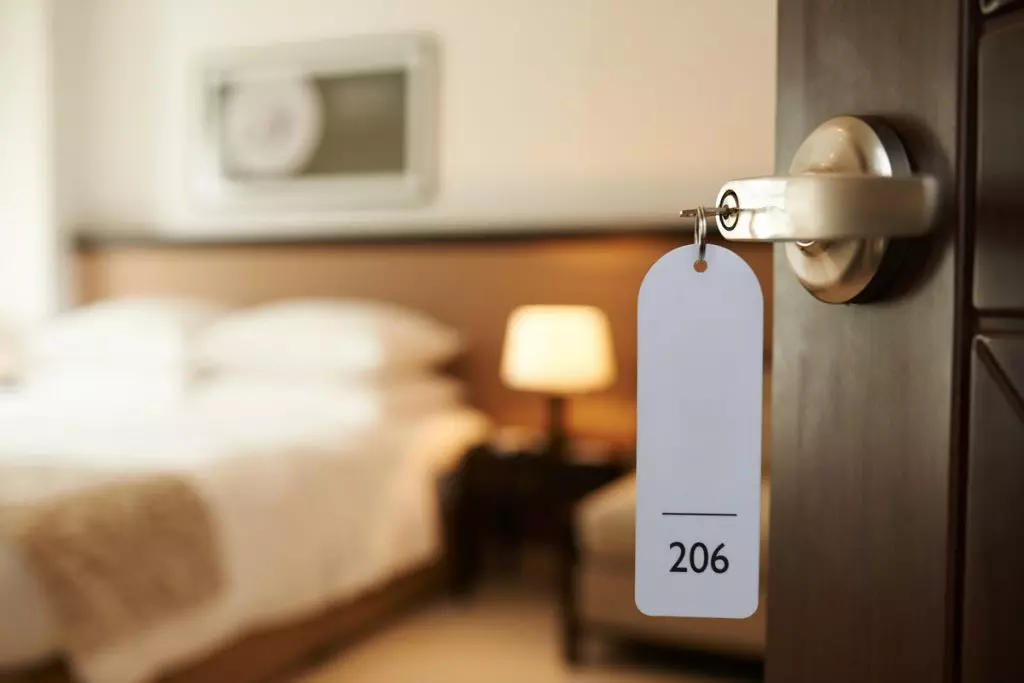What is the RevPAR Formula and How to Calculate It?
Right now, the hospitality industry is not so industrious. The hospitality industry was one of the industries hit worst by COVID-19. And while it’s slowly rebounding, the wound of nearly 3.1 million job losses in the hospitality and leisure industry is yet to heal.
To maintain a healthy hotel, especially right now, hotel managers and proprietors must have the tools to evaluate the full scope of their financial situation – where they are flourishing and where there is room to grow. Hotel proprietors can do just that by looking at their property’s metrics and applying those metrics to their benefit.
There are a ton of metrics you can put to use to grow your business. The most critical of these are total available rooms, average daily rate (ADR), average occupancy rate, and revenue per available room (RevPAR).
Learning how to calculate, interpret, and apply the RevPAR formula is necessary to ensure you have the means to stay afloat. Below, we’ll discuss some of these metrics and explain how to use them to your advantage
What is RevPAR?
RevPAR stands for Revenue Per Available Room. It builds upon ADR to measure the potential a property has to completely fill its occupancy and how much your hotel would earn from its occupancy.
In other words, using the RevPAR formula tells you how much money you stand to make from your property based on its occupancy rate.
RevPAR vs. ADR: What’s the Difference?
ADR stands for Available Daily Rate and shows the average rate hotels can charge for an available room during a given time period. This rate can be adjusted to match the current demand for rooms. It is a useful metric that can help predict seasonal trends.
For example, a hotel can choose to charge a higher rate per room during peak season or decrease the price when the demand is low to attract more customers.
We’ll see later on that ADR is part of the RevPAR formula and is needed to calculate the revenue per available room. And while it is still needed, RevPAR is a more important indicator because it also takes into account the daily occupancy of rooms apart from the daily rate.
Even though ADR doesn’t always show the full picture, it can help you identify demand trends and see whether your current strategies for attracting customers are working.
By looking at seasonal trends and comparing your ADR to that of your competitors, you can adjust it to attract more clients. For instance, if the demand is low and your prices are similar to your competitors, you can lower your ADR to draw more customers to your hotel.
How to Calculate RevPAR?
The general RevPAR formula is as follows:
RevPAR = ADR x Occupancy Rate
Here’s an example that demonstrates it better.
Let’s say your hotel has 50 rooms, out of which the average occupancy rate is 80%. The average daily rate for renting a room in a given period is $70 per night. Therefore, the revenue per average room would be:
RevPAR = 70 x 80% = $56
This means that the average revenue a single room generates is $56 per night.
Why RevPAR Is Important?
RevPAR is important because it’s the most commonly used metric in the hotel industry. Many other calculations are based on RevPAR, so you need to understand it before you can do much with your data.
Also, failing to understand how your business makes money is one of the mistakes that can lead to business bankruptcy.
RevPAR Alternatives
There are actually two distinct RevPAR calculations: NRevPAR and TRevPAR. These two calculations break down RevPAR in different ways so you can get a better picture of how much revenue your hotel can bring in and from which source that revenue is coming.

NRevPAR
Net RevPAR, or NRevPAR, finds a hotel’s net revenue (gross revenue – distribution costs) per available room. In other words, it is the total revenue generated from a room booking minus the cost of distribution of that booking.
While not as comprehensive as its relative, TRevPAR, NRevPAR is useful because it can be calculated for a specific period of time, such as a week, a month, or a year.
This is helpful when you want to compare revenue generated from a third-party website such as an online travel agency (OTA) versus a direct booking.
Both of these channels have their own distribution cost, so it’s helpful to weigh them against each other. Hotel proprietors should allocate their inventory to the lowest-cost channel first, according to NRevPAR.

TRevPAR
True RevPAR, or TRevPAR, paints a more holistic portrait of a hotel’s revenue. TRev is the total revenue per available room. It tells you the average amount of money a guest is spending at your hotel, all things considered. Like NRevPAR, it can be calculated for a defined period of time, such as a week, month, or year.
If your hotel offers additional amenities besides a bed to sleep in (perhaps room service, a bar or restaurant, a spa, gym access, or local tours), TRevPAR will give you a more accurate estimate of the revenue you’re bringing in per room, on average. Otherwise, NRevPAR should suffice for your purposes.
You can use this metric to evaluate how much money your hotel’s amenities are bringing in. What’s particularly useful is that you can divide up this calculation to reflect revenue from a particular service, for example, revenue from the spa vs. revenue from your on-site bar. This will allow you to see how well specific attractions at your hotel are doing.
How to Calculate NRevPAR and TRevPAR
NRevPAR and TRevPAR formulas differ from RevPAR formula and are calculated using different metrics. Thus their formulas differ. Hotels that offer amenities at an additional charge will want to use TRevPAR for greater accuracy. For hotels on the bare-bones side, NRevPAR will suffice. Let’s first look at the NRevPAR formula.

Calculating NRevPAR
You don’t need a RevPar calculator to do the equation. It’s simple enough to do without one. There are two ways to calculate NRevPAR:
- Divide total rooms revenue minus distribution cost by total rooms available
- Multiply ADR by the occupancy rate
How to Calculate NRevPAR: Method #1
The first formula for calculating NRevPAR is:
NRevPar = (Total Rooms Revenue – Related Distribution Costs) / Total Rooms Available
The formula is fairly straightforward. You subtract the costs of booking a room from the total revenue from room bookings in a defined period of time. Then, divide that number by the total number of available rooms.
How to Calculate NRevPAR: Method #2
Alternatively, you can multiply the ADR by the occupancy rate. Here are the steps to calculate ADR:
1. Find ADR
ADR tells you how much you’re making on room bookings per day. To calculate ADR, you will need to find room revenue and rooms sold over a specified period of time. Then, divide the first number by the second. The formula for calculating ADR is as follows:
ADR = room revenue / rooms occupied
ADR only factors in revenue generated by the room booking itself. Do not include revenue from other services charged to the room, such as bar or room service.
2. Find occupancy rate
The occupancy rate is the percentage of occupied rooms during the specified period you are calculating the ADR for. A hotel with every room booked for a given week has an occupancy rate of 100%, while a hotel with no rooms booked would have an occupancy rate of 0%.
3. Multiply both numbers
Now that you have both the ADR and occupancy rate, you can find NRevPAR using this formula:
NRevPAR = ADR * Occupancy Rate
NRevPAR Calculation Example
Let’s look at two examples of how you would calculate NRevPAR using these formulas.
NRevPAR Formula #1
You have a large hotel that holds a 400 room occupancy. The hotel is well known in the area and is a popular spot for tourists looking for an island getaway.
It’s Summer, the time of year when your business is booming. Last week:
Your occupancy rate was 95%.
You received a total of $125,000 from booking sales alone.
You were charged a total of $1,000 for various distribution costs to travel agency websites.
Here is how to find your NRevPAR for the past week:
NRevPAR = (Total Rooms Revenue – Related Distribution Costs) / Total Rooms Available
NRevPAR = ($125,000 – $1,000) / 400
NRevPAR = $310
Your NRevPAR for the past week is $310, meaning that, on average, it cost guests $310 to book a night at your hotel.
NRevPAR Formula #2
Let’s find NRevPAR using the same numbers but a different formula. There are three steps to this process:
- Find ADR
- Find occupancy rate
- Multiply ADR by the occupancy rate
ADR = Room Revenue / Rooms Occupied
ADR = $124,000 / 380
ADR = $327
As stated above, your occupancy rate is 95%. So, you would multiply this percentage as a decimal (.95).
Now, we can find NRevPAR using the formula
NRevPAR = ADR * Occupancy Rate
NRevPAR = 327 * 0.95
NRevPAR = 310
Using this formula, we get the same conclusion as we did in method #1. You should get the same answer whichever formula you use.
Calculating TRevPAR
True RevPAR, or TRevPAR, calculates the total amount of revenue your hotel makes per room. The formula for calculating TRevPAR is
TRevPAR = Total revenue – Related Distribution Costs / Total Available Rooms
Note that the calculation for TRevPAR includes more than the room booking. “Total revenue” includes money from sources like:
- Restaurants
- Self-parking or valet parking
- Extended stay or late checkout
- Room service
- Smoking rooms
- WiFi
- Cable television
- Spa
- Gym
- Room customization offers
- Extras like mugs, fancy bathrobes, and other merchandise
All of these income-generating channels (and others your hotel offers) are added to room revenue to find total revenue.
TRevPAR Calculation Example
You want to find out how much, on average, a room costs at your hotel — all expenses considered.
Your top-of-the-line luxury hotel generates a lot of additional revenue through its many paid amenities. On the week you calculated NRevPAR, the restaurant and bar, spa, room service, and room customization options bring in a total of $25,000. Including the $124,000 you made in room booking revenue, the total your hotel made that week was $149,000.
TRevPAR = Total Revenue – Distribution Costs / Total Available Rooms
TRevPAR = $149,000 / 400
TRevPAR = $373
This means that the average amount each room spent per night was $373.
How to Interpret RevPAR and TRevPAR
When interpreting RevPAR, the first thing to understand is that RevPAR reflects a hotel’s ability to book available rooms on average. RevPAR gives you a good overview of your hotel’s operations, but it doesn’t reflect the nuances of the money your hotel is generating.

Your TRevPAR in the example above may be $373, but not every guest will spend $373 per night. Unless you offer no additional amenities and no room upgrades, not every guest will spend the same amount of money per night.
Some guests may prefer a more expensive room, which will increase the rate they pay in room revenue alone. Then, they may want to order drinks at the bar and utilize room service. That will run their bill up far higher than the more frugal guest who doesn’t want to pay for anything other than the room.
RevPAR won’t reflect the difference in money spent by the extravagant guest versus the frugal guest; it will only average the difference.
Collecting data on which rooms net you the most money gives you a more detailed view of your hotel’s financial standing. You can create a RevPar Index to compare your revenue per room to your competitors.
Understanding Your Customers
You have to know your customers so you can tailor your services to them. Ask yourself:
- What is your demographic? Are they extravagant? Thrifty? A combination of both?
- Who are the big spenders?
- What are they spending money on?
- How can I cater my services to those guests?

Let’s say you determine that the amenity that brings in the most money is your restaurant and bar. It might be useful to look at what the most popular dish is. You might then ask, is there a crossover between guests who buy drinks at the bar and guests who spend money at the spa?
Likely, the subset of guests spending money on food and drinks are also the same guests spending money at the spa or on room service. Once you understand where the revenue is coming from — what channels and from whom — you can focus on catering to high-paying guests to increase revenue.
RevPAR Limitations
The next thing to understand is that an increase in RevPAR does not necessarily mean an increase in profit. This is because RevPAR doesn’t consider the size of a hotel. You may have a high RevPAR but a low occupancy rate or vice versa. Therefore, you want to focus on increasing RevPAR without decreasing profit margins.
If you only look at RevPAR and nothing else, take that number with a grain of salt. To get the most out of RevPAR, you should consider it along with ADR, which may be a better performance measure. ADR takes into consideration hotel occupancy, whereas RevPAR does not. If your occupancy rate increases, so will your revenue.
Table of Contents
- What is RevPAR?
- RevPAR vs. ADR: What’s the Difference?
- How to Calculate RevPAR?
- Why RevPAR Is Important?
- RevPAR Alternatives
- NRevPAR
- TRevPAR
- How to Calculate NRevPAR and TRevPAR
- Calculating NRevPAR
- How to Calculate NRevPAR: Method #1
- How to Calculate NRevPAR: Method #2
- NRevPAR Calculation Example
- NRevPAR Formula #1
- NRevPAR Formula #2
- Calculating TRevPAR
- TRevPAR Calculation Example
- How to Interpret RevPAR and TRevPAR
- Understanding Your Customers
- RevPAR Limitations